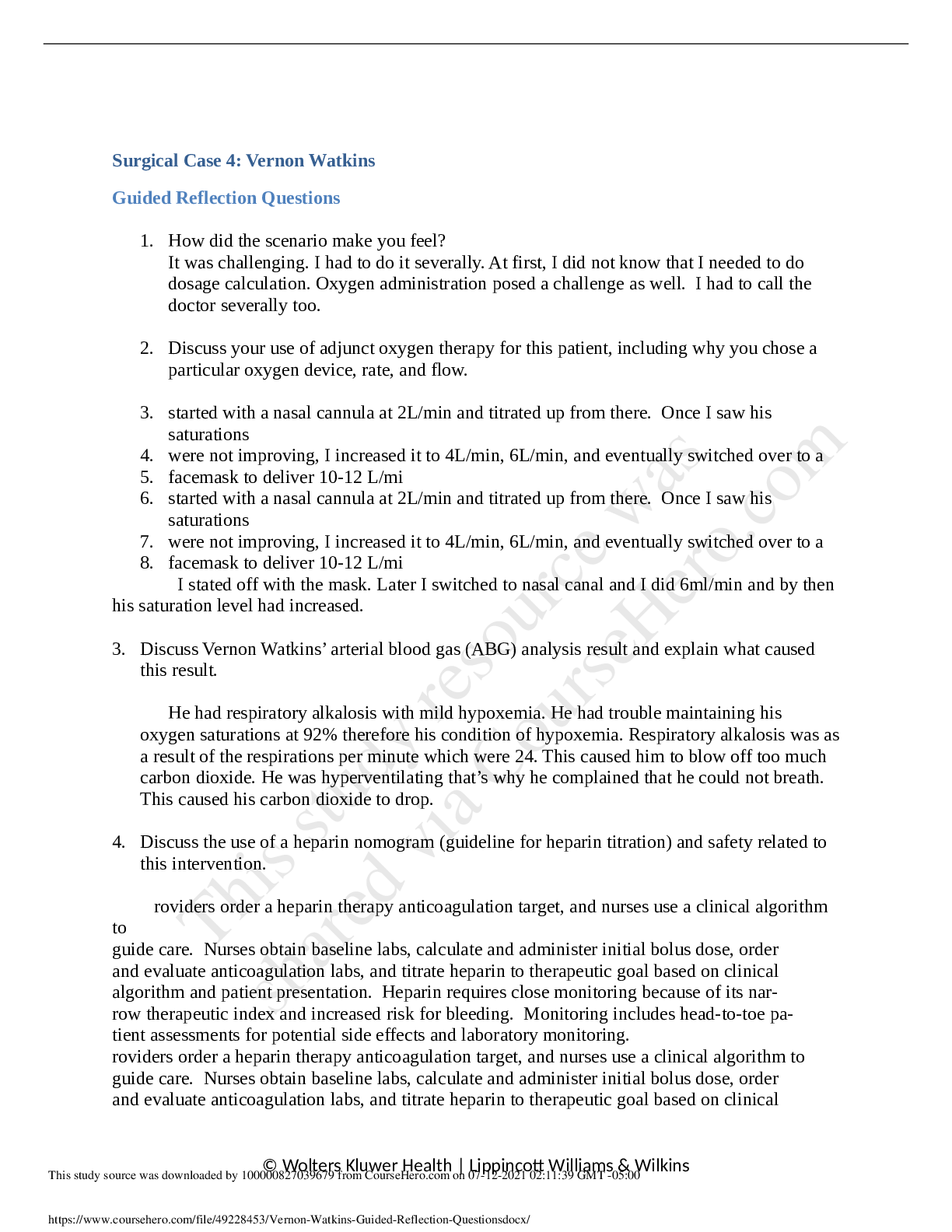*NURSING > QUESTIONS & ANSWERS > Vernon Watkins Guided Reflection Questions. (All)
Vernon Watkins Guided Reflection Questions.
Document Content and Description Below
Surgical Case 4: Vernon Watkins Guided Reflection Questions 1. How did the scenario make you feel? It was challenging. I had to do it severally. At first, I did not know that I needed to do dosage... calculation. Oxygen administration posed a challenge as well. I had to call the doctor severally too. 2. Discuss your use of adjunct oxygen therapy for this patient, including why you chose a particular oxygen device, rate, and flow. 3. started with a nasal cannula at 2L/min and titrated up from there. Once I saw his saturations 4. were not improving, I increased it to 4L/min, 6L/min, and eventually switched over to a 5. facemask to deliver 10-12 L/mi 6. started with a nasal cannula at 2L/min and titrated up from there. Once I saw his saturations 7. were not improving, I increased it to 4L/min, 6L/min, and eventually switched over to a 8. facemask to deliver 10-12 L/mi I stated off with the mask. Later I switched to nasal canal and I did 6ml/min and by then his saturation level had increased. 3. Discuss Vernon Watkins’ arterial blood gas (ABG) analysis result and explain what caused this result. He had respiratory alkalosis with mild hypoxemia. He had trouble maintaining his oxygen saturations at 92% therefore his condition of hypoxemia. Respiratory alkalosis was as a result of the respirations per minute which were 24. This caused him to blow off too much carbon dioxide. He was hyperventilating that’s why he complained that he could not breath. This caused his carbon dioxide to drop. 4. Discuss the use of a heparin nomogram (guideline for heparin titration) and safety related to this intervention. roviders order a heparin therapy anticoagulation target, and nurses use a clinical algorithm to guide care. Nurses obtain baseline labs, calculate and administer initial bolus dose, order and evaluate anticoagulation labs, and titrate heparin to therapeutic goal based on clinical algorithm and patient presentation. Heparin requires close monitoring because of its narrow therapeutic index and increased risk for bleeding. Monitoring includes head-to-toe patient assessments for potential side effects and laboratory monitoring. roviders order a heparin therapy anticoagulation target, and nurses use a clinical algorithm to guide care. Nurses obtain baseline labs, calculate and administer initial bolus dose, order and evalua [Show More]
Last updated: 2 years ago
Preview 1 out of 4 pages

Buy this document to get the full access instantly
Instant Download Access after purchase
Buy NowInstant download
We Accept:

Also available in bundle (1)

Vernon Watkins Guided Reflection and Documentation Assignments PACKAGE |(100% Guaranteed Pass)
Vernon Watkins Guided Reflection and Documentation Assignments PACKAGE |(100% Guaranteed Pass)
By d.occ 4 years ago
$19
5
Reviews( 0 )
$7.00
Can't find what you want? Try our AI powered Search
Document information
Connected school, study & course
About the document
Uploaded On
Jul 12, 2021
Number of pages
4
Written in
Additional information
This document has been written for:
Uploaded
Jul 12, 2021
Downloads
0
Views
186








.png)

.png)



